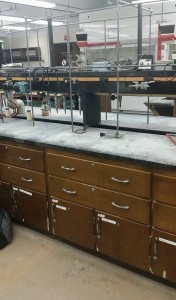by Briana Reilly
Undergraduate and graduate chemistry students, flocked by supportive family members and friends, loudly filed into a large and rather decrepit chemistry lecture hall, a space typically frequented by tired and burnt-out science majors, trudging to their twice weekly classes. A loud twanging bell at 3:30 announced the start of the event, and programmed from a lifetime of attending classes, the students quieted immediately.
University of Wisconsin-Madison Chemistry Department Chair and Professor Robert
McMahon stepped on the narrow stage and assessed the crowd. Not a professional communicator by trade, he took some time to gather himself before formally starting the program. After a short pause, he began. “Welcome to the 2015 Student Awards Ceremony,” he meekly intoned.

McMahon kicked off the ceremony with a PowerPoint presentation, dictating the overall benefits of UW-Madison’s chemistry program in the areas of education, service and research. He spoke of outdated lab equipment, crowded lab spaces and the hope of a new chemistry building, funded by the state.
This is a step that has been taken by departments across UW-Madison in response to the biennial budget, which contains a $300 million proposed cut to the UW System. Schools and colleges have made additional moves to show state residents how their work positively impacts Wisconsin.
Seeking to inform but not to lobby citizens, the departments and the greater UW Communications as a whole aim to be straightforward in sharing the nature of things at the university, according to UW Communications Executive Director John Lucas.
Lucas also stressed that it’s not UW Communication’s task to reach out to legislators specifically, but to university alumni and state residents.
“[UW Communications wants] people see our news not in a propaganda way, but in a straightforward way. If then you feel it should be different, you have a voice, and you can contact your legislator and tell him or her why it is important,” Lucas said.
Additionally, Lucas explained that UW Communications, through this practice of sharing university news with state residents, is living out the Wisconsin Idea.
“If there’s a cool research discovery, we write about that – that’s more to the mission of the university, to disseminate knowledge … to take things that happen here and share them with the state and the world,” Lucas said.
However, within UW Communications, there are slight differences in terms of operation. UW Communications Content Strategist Sandra Knisely described the application of the Wisconsin Idea to her specific line of work as being “just about outreach” and more of a brand for that knowledge dissemination process.
However, Knisely doesn’t understate the importance of the Wisconsin Idea itself; she just sees it as a separate entity from the budget. Recently, she, as content strategist, has made efforts to communicate with and specifically target smaller media outlets across the state, areas that hadn’t before been needed. When asked what dictated this transition, Knisely said, “It has become clear that we need to refocus our effort on communicating our values to residents of the state.”
Part of the need for refocusing efforts to communicate the university’s values may be due to Gov. Scott Walker’s budget drafting error in February, as hinted at by Knisely, which revised UW’s 111-year-old mission statement, deleting a principle reading “basic to every purpose of the system is the search for truth.”
Knisely did say that following Walker’s drafting error, more and more individuals began turning to the UW Communications-managed Twitter account, The Wisconsin Idea. Describing the drafting error as a “fascinating moment,” Knisely recalled how it drove traffic to The Wisconsin Idea Twitter feed, strengthening its identity and brand.
Knisely was then able to shift the language from a political conversation about the budget to news of what the university does, retaining some of the initial flock of followers and spreading the information commonly shared by UW Communications, that of knowledge- and research- based communications.
However, aside from a renewed emphasis to explain the Wisconsin Idea, which has always been part of Knisely’s core duties, and a stronger platform to do it on, Lucas said that UW Communications as a whole wasn’t operating any differently in response to the budget.
“[We] showcase these stories to the media to show what UW brings to the state – not unlike what we do on a normal basis. Whether it’s budget season or not, if there’s a cool research discovery, we write about that,” Lucas said.
However, Lucas said there were certain important messages to get across, namely regarding calls by legislators for professors to simply teach more.
“It’s on us to explain how we work. It’s not super intuitive, but part of a complex culture,” Lucas said.
Lucas also explained the importance of notifying lawmakers about the impact of budget cuts, saying, “It’s important that legislators know what’s happening here and the impact of what would happen if funding is reduced.”
For more on this topic, click here.
